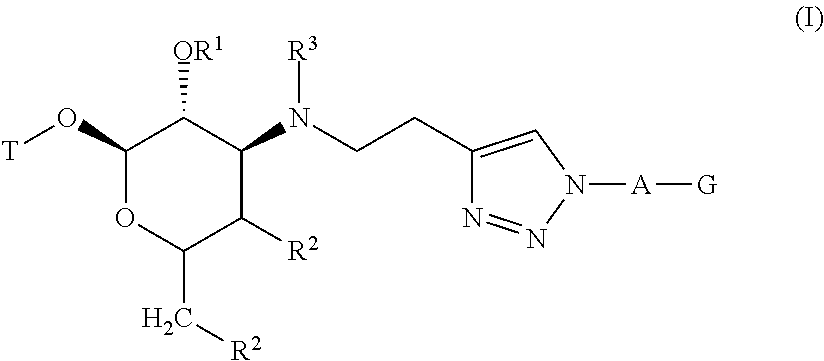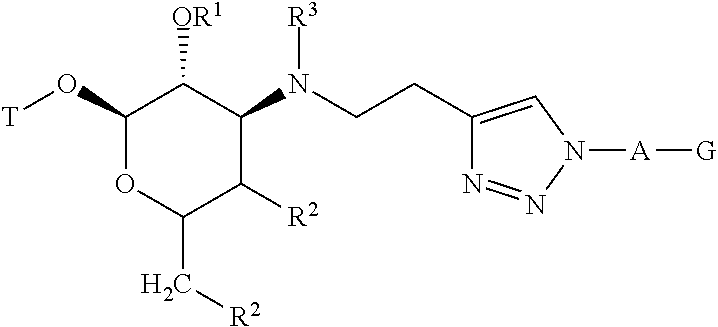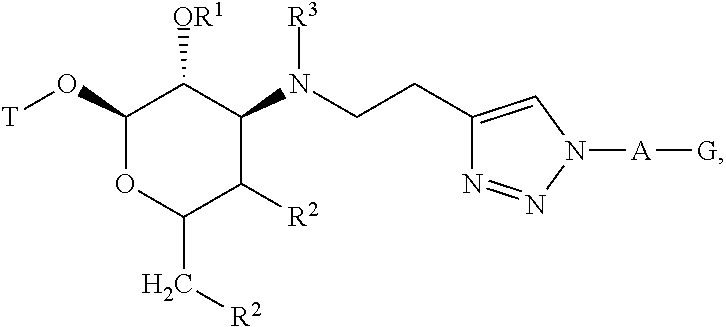Triazole compounds and methods of making and using the same
a technology of triazole and compound, applied in the field of antiinfective, antiproliferative, antiinflammatory, prokinetic agents, etc., can solve the problems of affecting the treatment effect of patients infected with such resistant bacteria, affecting the treatment effect, and ultimately encountering problems with antibiotic agents developed for clinical us
- Summary
- Abstract
- Description
- Claims
- Application Information
AI Technical Summary
Benefits of technology
Problems solved by technology
Method used
Image
Examples
example 1
Synthesis of Compounds 101-198
[0325]Schemes 100-101 and Table 2 below relate to the synthesis of compounds 101-198. Compounds 101-148, 151-160, 162, 164, 165, 183, 184, and 191-198 were made via the alkynyl intermediate, 3.
[0326]Alkynyl intermediate 3 was made by selective demethylation of azithromycin 1 to produce 3′-N-desmethylazithromycin 2. This compound 2 was selectively alkylated with alkynyl tosylate 11 to produce alkyne 3, respectively. As shown in Scheme 101 alkyne 3 is reacted with corresponding azides 14 in the presence of copper (I) iodide to selectively afford the triazoles 101-149, 151-160, 162, 164, 165, 183, 184, and 191-198.
[0327]The compounds 163, 168, 171-182, and 185-190 were made from azide compound 161. Azide compound 161 was made from amino compound 150, which in turn was made from nitro compound 147.
[0328]The compounds 169 and, 170 were made from azide compound 167. Azide compound 167 was made from amino compound 166, which in turn was made from nitro compoun...
example 2
Synthesis of Compounds 201-207 and 226
[0404]Schemes 103 and 104 below depict the synthesis of compounds 201-207 and 226. See Table 3. Demethylation of clarithromycin yielded 3′-N-desmethyl-clarithromycin 21. Amine 21 was selectively N-alkylated with tosylates 11 to produce alkyne 27. As shown in Scheme 104 alkyne 27 is reacted with corresponding azides 14 in the presence of copper (I) iodide to selectively afford the triazoles 201-207 and 226.
[0405]
Synthesis of 3′-N-desmethyl-clarithromycin 21
[0406]To a mixture of clarithromycin (1.00 g, 1.3 mmol) and NaOAc-3H2O (0.885 g, 6.5 mmol) was added MeOH—H2O (20 mL, 4:1), and the mixture heated to 55-60° C. Iodine (0.330 g, 1.3 mmol) was added portion-wise and the reaction stirred at 55-60° C. for 3 h. The reaction mixture was poured into 50 mL CHCl3 containing 1 mL ammonium hydroxide. It was extracted with CHCl3 (4×50 mL), washed with water (70 mL) containing 5 mL ammonium hydroxide, dried (anhydrous Na2SO4), concentrated, and purified by ...
example 3
Synthesis of Compounds 210-213
[0409]The macrolide oximes 210-213, see Table 4, were synthesized from alkynes 400a to 400c by copper (I)-promoted cycloaddition with corresponding azides 14 in a manner analogous to the procedures presented previously. Alkyne precursors with substituted oxime functionality at the 9-position of the macrocyclic ring were prepared from alkyne 27 and as shown below.
[0410]
Synthesis of Alcohol 27a
[0411]To the alkyne 27 (0.700 g) was added 10 mL 0.9N HCl and the mixture was stirred for 4 h at room temperature. The reaction mixture was saturated with sodium chloride and was adjusted to pH 8 using aqueous NH4OH solution. The solution was extracted with ethyl acetate (3×30 mL), dried (with Na2SO4), and concentrated under reduced pressure. Purification of the crude reaction mixture by flash chromatography (silica gel, 60% ethyl acetate in hexane) afforded 0.200 g (35% yield) of the descladinose derivative 27. Data for 27: 1HNMR (300 MHz, CDCl3, partial): δ 0.82 (...
PUM
| Property | Measurement | Unit |
|---|---|---|
| thick | aaaaa | aaaaa |
| pH | aaaaa | aaaaa |
| temperature | aaaaa | aaaaa |
Abstract
Description
Claims
Application Information
 Login to View More
Login to View More - R&D
- Intellectual Property
- Life Sciences
- Materials
- Tech Scout
- Unparalleled Data Quality
- Higher Quality Content
- 60% Fewer Hallucinations
Browse by: Latest US Patents, China's latest patents, Technical Efficacy Thesaurus, Application Domain, Technology Topic, Popular Technical Reports.
© 2025 PatSnap. All rights reserved.Legal|Privacy policy|Modern Slavery Act Transparency Statement|Sitemap|About US| Contact US: help@patsnap.com



